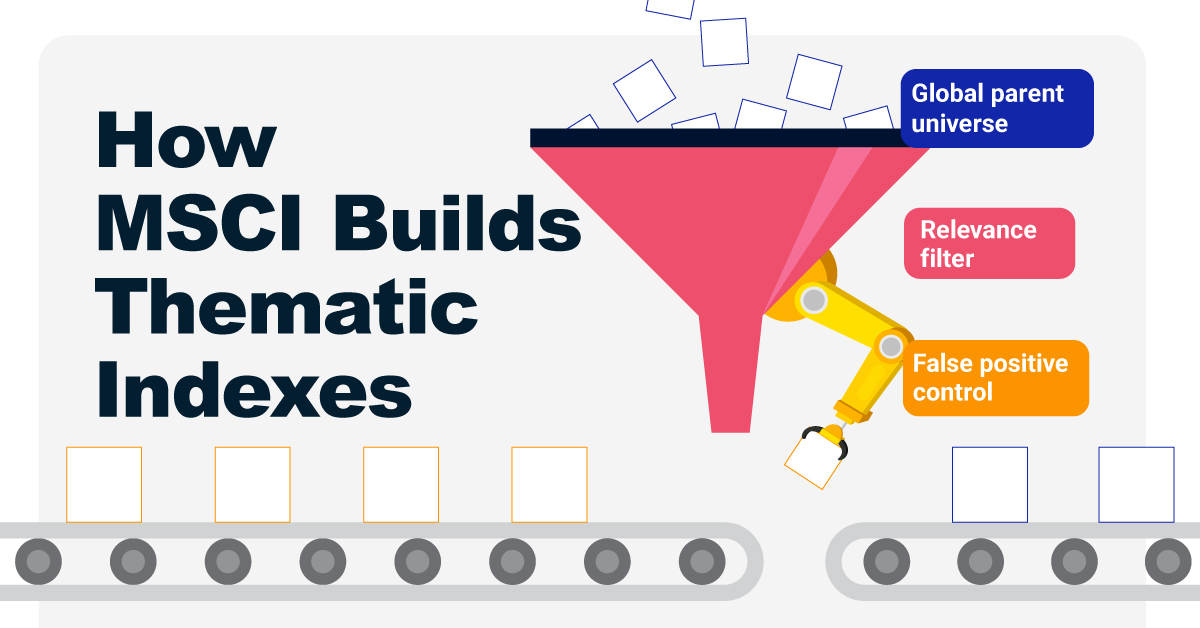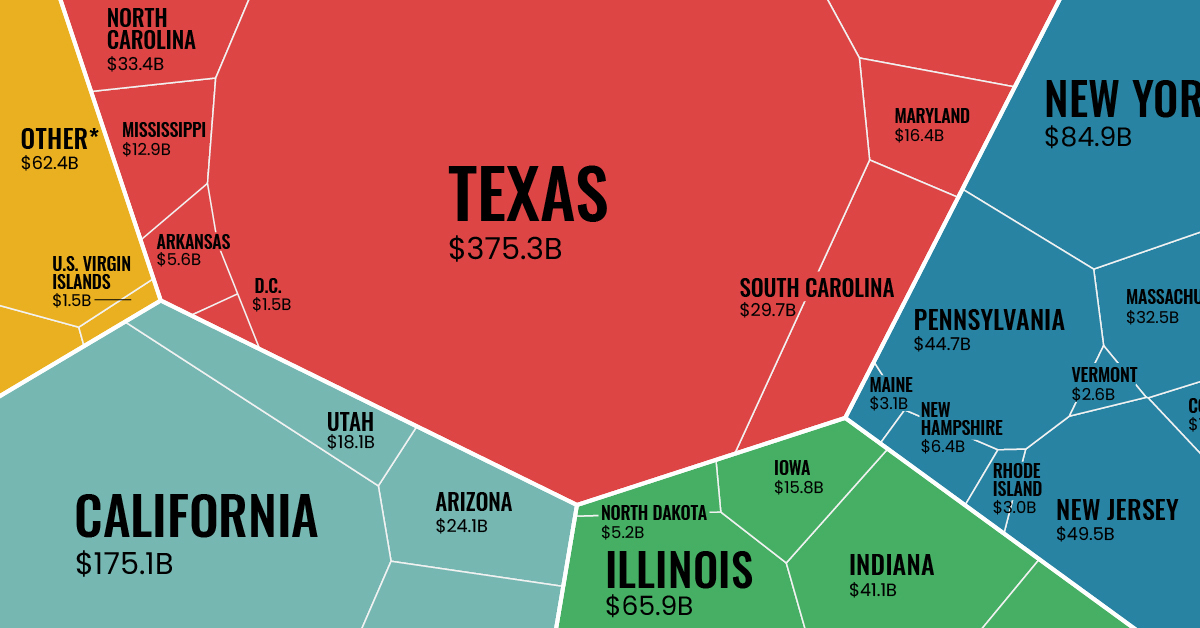Markets
Made in America: Goods Exports by State

Made in America: Goods Exports by State
After China, the U.S. is the next largest exporter of goods in the world, shipping out $1.8 trillion worth of goods in 2021—an increase of 23% over the previous year.
Of course, that massive number doesn’t tell the whole story. The U.S. economy is multifaceted, with varying levels of trade activity taking place all across the nation.
Using the latest data on international trade from the U.S. Census Bureau and the U.S. Bureau of Economic Analysis, we’ve visualized the value of America’s goods exports by state.
Top 10 Exporter States
Here are the top 10 American states that exported the highest dollar value worth of goods during 2021. Combined, these export-leading states represent 59.4% of the nation’s total exports.
| Rank | State | Total Exports Value | % share |
|---|---|---|---|
| #1 | Texas | $375.3 billion | 21.4% |
| #2 | California | $175.1 billion | 10.0% |
| #3 | New York | $84.9 billion | 4.8% |
| #4 | Louisiana | $76.8 billion | 4.4% |
| #5 | Illinois | $65.9 billion | 3.8% |
| #6 | Michigan | $55.5 billion | 3.2% |
| #7 | Florida | $55.5 billion | 3.2% |
| #8 | Washington | $53.6 billion | 3.1% |
| #9 | Ohio | $50.4 billion | 2.9% |
| #10 | New Jersey | $49.5 billion | 2.8% |
| Top 10 States | $1.04 trillion | 59.4% |
Texas has been the top exporting state in the U.S. for an incredible 20 years in a row.
Last year, Texas exported $375 billion worth of goods, which is more than California ($175 billion), New York ($85 billion), and Louisiana ($77 billion) combined. The state’s largest manufacturing export category is petroleum and coal products, but it’s also important to mention that Texas led the nation in tech exports for the ninth straight year.
California was the second highest exporter of goods in 2021 with a total value of $175 billion, an increase of 12% from the previous year. The state’s main export by value was computer and electronic product manufacturing, representing 17.8% of the total U.S. exports of that industry. California was also second among all states in exports of machinery manufacturing, accounting for 13.9% of the U.S. total.
What Type of Goods are Exported?
Here is a breakdown of the biggest U.S. export categories by value in 2021.
| Rank | Product Group | Annual Export Value (2021) | Share of Total Exports |
|---|---|---|---|
| 1 | Mineral fuels including oil | $239.8 billion | 13.7% |
| 2 | Machinery including computers | $209.3 billion | 11.9% |
| 3 | Electrical machinery, equipment | $185.4 billion | 10.6% |
| 4 | Vehicles | $122.2 billion | 7.0% |
| 5 | Optical, technical, medical apparatus | $91.7 billion | 5.2% |
| 6 | Aircraft, spacecraft | $89.1 billion | 5.1% |
| 7 | Gems, precious metals | $82.3 billion | 4.7% |
| 8 | Pharmaceuticals | $78 billion | 4.4% |
| 9 | Plastics, plastic articles | $74.3 billion | 4.2% |
| 10 | Organic chemicals | $42.9 billion | 2.4% |
These top 10 export categories alone represent almost 70% of America’s total exports.
The biggest grower among this list is mineral fuels, up by 59% from last year. Pharmaceuticals saw the second biggest one-year increase (45%).
Top 10 U.S. Exports by Country of Destination
So who is buying “Made in America” products?
Unsurprisingly, neighboring countries Canada (17.5%) and Mexico (15.8%) are the two biggest buyers of American goods. Together, they purchase one-third of American exports.
| Rank | Destination Country | Share of U.S. Goods Exports |
|---|---|---|
| 1 | 🇨🇦 Canada | 17.5% |
| 2 | 🇲🇽 Mexico | 15.8% |
| 3 | 🇨🇳 China | 8.6% |
| 4 | 🇯🇵 Japan | 4.3% |
| 5 | 🇰🇷 South Korea | 3.7% |
| 6 | 🇩🇪 Germany | 3.7% |
| 7 | 🇬🇧 United Kingdom | 3.5% |
| 8 | 🇳🇱 Netherlands | 3.1% |
| 9 | 🇧🇷 Brazil | 2.7% |
| 10 | 🇮🇳 India | 2.3% |
Three Asian countries round out the top five list: China (8.6%), Japan (4.3%), and South Korea (3.7%). Together, the top five countries account for around half of all goods exports.
Investor Education
How MSCI Builds Thematic Indexes: A Step-by-Step Guide
From developing an index objective to choosing relevant stocks, this graphic breaks down how MSCI builds thematic indexes using examples.

How MSCI Builds Thematic Indexes: A Step-by-Step Guide
Have you ever wondered how MSCI builds its thematic indexes?
To capture long-term, structural trends that could drive business performance in the future, the company follows a systematic approach. This graphic from MSCI breaks down each step in the process used to create its thematic indexes.
Step 1: Develop an Index Objective
MSCI first builds a broad statement of what the theme aims to capture based on extensive research and insights from industry experts.
Steps 2 and 3: List Sub-Themes, Generate Keyword List
Together with experts, MSCI creates a list of sub-themes or “seedwords” to identify aligned business activities.
The team then assembles a collection of suitable documents describing the theme. Natural language processing efficiently analyzes word frequency and relevance to generate a more detailed set of keywords contextually similar to the seedwords.
Step 4: Find Relevant Companies
By analyzing financial reports, MSCI picks companies relevant to the theme using two methods:
- Direct approach: Revenue from a company’s business segment is considered 100% relevant if the segment name matches a theme keyword. Standard Industrial Classification (SIC) codes from these directly-matched segments make up the eligible SIC code list used in the indirect approach.
- Indirect approach: If a segment name doesn’t match theme keywords, MSCI will:
- Analyze the density of theme keywords mentioned in the company’s description. A minimum of two unique keywords is required.
- The keyword density determines a “discount factor” to reflect lower certainty in theme alignment.
- Revenue from business segments with an eligible SIC code, regardless of how they are named, is scaled down by the discount factor.
The total percentage of revenue applicable to the theme from both approaches determines a company’s relevance score.
Step 5: Select the Stocks
Finally, MSCI narrows down the stocks that will be included:
- Global parent universe: The ACWI Investable Market Index (IMI) is the starting point for standard thematic indexes.
- Relevance filter: The universe is filtered for companies with a relevance score of at least 25%.
- False positive control: Eligible companies that are mapped to un-related GICS sub-industries are removed.
Companies with higher relevance scores and market caps have a higher weighting in the index, with the maximum weighting for any one issuer capped at 5%. The final selected stocks span various sectors.
MSCI Thematic Indexes: Regularly Updated and Rules-Based
Once an index is built, it is reviewed semi-annually and updated based on:
- Changes to the parent index
- Changes at individual companies
- Theme developments based on expert input
Theme keywords are reviewed yearly in May. Overall, MSCI’s thematic index construction process is objective, scalable, and flexible. The process can be customized based on the theme(s) you want to capture.

Learn more about MSCI’s thematic indexes.

-

 Investor Education5 months ago
Investor Education5 months agoThe 20 Most Common Investing Mistakes, in One Chart
Here are the most common investing mistakes to avoid, from emotionally-driven investing to paying too much in fees.
-

 Stocks10 months ago
Stocks10 months agoVisualizing BlackRock’s Top Equity Holdings
BlackRock is the world’s largest asset manager, with over $9 trillion in holdings. Here are the company’s top equity holdings.
-

 Investor Education10 months ago
Investor Education10 months ago10-Year Annualized Forecasts for Major Asset Classes
This infographic visualizes 10-year annualized forecasts for both equities and fixed income using data from Vanguard.
-

 Investor Education1 year ago
Investor Education1 year agoVisualizing 90 Years of Stock and Bond Portfolio Performance
How have investment returns for different portfolio allocations of stocks and bonds compared over the last 90 years?
-

 Debt2 years ago
Debt2 years agoCountries with the Highest Default Risk in 2022
In this infographic, we examine new data that ranks the top 25 countries by their default risk.
-

 Markets2 years ago
Markets2 years agoThe Best Months for Stock Market Gains
This infographic analyzes over 30 years of stock market performance to identify the best and worst months for gains.
-

 Money2 weeks ago
Money2 weeks agoVisualizing the Growth of $100, by Asset Class (1970-2023)
-

 Money1 week ago
Money1 week agoWhere Does One U.S. Tax Dollar Go?
-

 Green2 weeks ago
Green2 weeks agoRanked: Top Countries by Total Forest Loss Since 2001
-

 Real Estate2 weeks ago
Real Estate2 weeks agoVisualizing America’s Shortage of Affordable Homes
-

 Maps2 weeks ago
Maps2 weeks agoMapped: Average Wages Across Europe
-

 Mining2 weeks ago
Mining2 weeks agoCharted: The Value Gap Between the Gold Price and Gold Miners
-

 Demographics2 weeks ago
Demographics2 weeks agoVisualizing the Size of the Global Senior Population
-

 Automotive2 weeks ago
Automotive2 weeks agoTesla Is Once Again the World’s Best-Selling EV Company


















